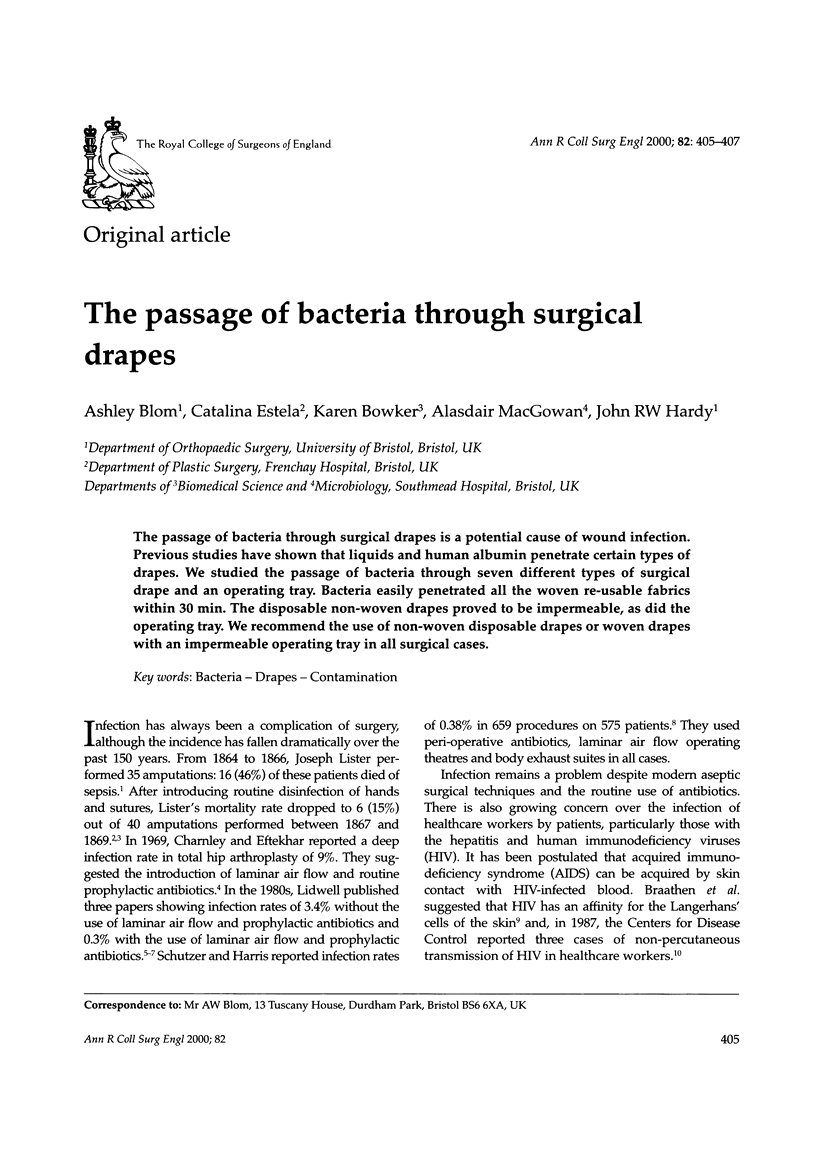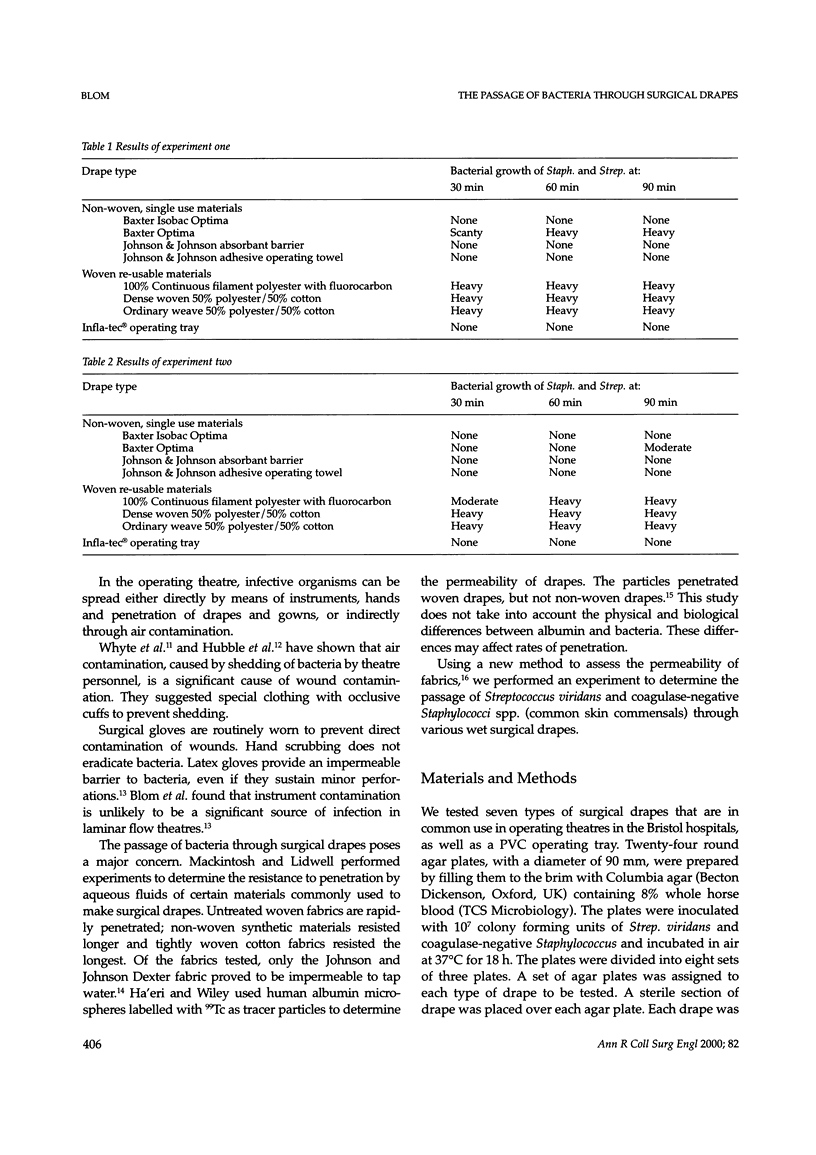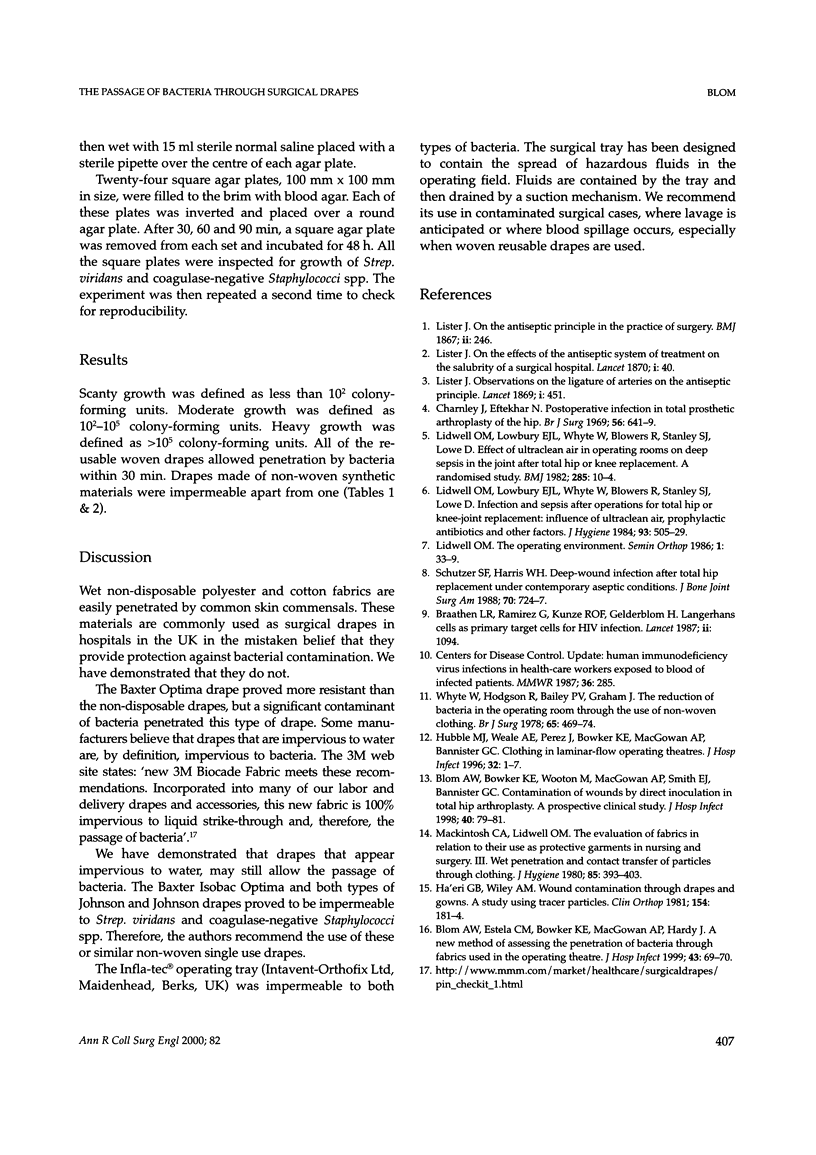Abstract
The passage of bacteria through surgical drapes is a potential cause of wound infection. Previous studies have shown that liquids and human albumin penetrate certain types of drapes. We studied the passage of bacteria through seven different types of surgical drape and an operating tray. Bacteria easily penetrated all the woven re-usable fabrics within 30 min. The disposable non-woven drapes proved to be impermeable, as did the operating tray. We recommend the use of non-woven disposable drapes or woven drapes with an impermeable operating tray in all surgical cases.
Full text
PDF


Selected References
These references are in PubMed. This may not be the complete list of references from this article.
- Blom A. W., Bowker K. E., Wooton M., MacGowan A. P., Smith E. J., Bannister G. C. Contamination of wounds by direct inoculation in total hip arthroplasty: a prospective clinical study. J Hosp Infect. 1998 Sep;40(1):79–80. doi: 10.1016/s0195-6701(98)90029-9. [DOI] [PubMed] [Google Scholar]
- Blom A. W., Estela C. M., Bowker K. E., MacGowan A. P., Hardy J. R. A new method of assessing the penetration of bacteria through fabrics used in the operating theatre. J Hosp Infect. 1999 Sep;43(1):69–70. doi: 10.1053/jhin.1999.0604. [DOI] [PubMed] [Google Scholar]
- Braathen L. R., Ramirez G., Kunze R. O., Gelderblom H. Langerhans cells as primary target cells for HIV infection. Lancet. 1987 Nov 7;2(8567):1094–1094. doi: 10.1016/s0140-6736(87)91526-1. [DOI] [PubMed] [Google Scholar]
- Centers for Disease Control (CDC) Update: human immunodeficiency virus infections in health-care workers exposed to blood of infected patients. MMWR Morb Mortal Wkly Rep. 1987 May 22;36(19):285–289. [PubMed] [Google Scholar]
- Charnley J., Eftekhar N. Postoperative infection in total prosthetic replacement arthroplasty of the hip-joint. With special reference to the bacterial content of the air of the operating room. Br J Surg. 1969 Sep;56(9):641–649. doi: 10.1002/bjs.1800560902. [DOI] [PubMed] [Google Scholar]
- Ha'eri G. B., Wiley A. M. Wound contamination through drapes and gowns: a study using tracer particles. Clin Orthop Relat Res. 1981 Jan-Feb;(154):181–184. [PubMed] [Google Scholar]
- Hubble M. J., Weale A. E., Perez J. V., Bowker K. E., MacGowan A. P., Bannister G. C. Clothing in laminar-flow operating theatres. J Hosp Infect. 1996 Jan;32(1):1–7. doi: 10.1016/s0195-6701(96)90159-0. [DOI] [PubMed] [Google Scholar]
- Lidwell O. M., Lowbury E. J., Whyte W., Blowers R., Stanley S. J., Lowe D. Effect of ultraclean air in operating rooms on deep sepsis in the joint after total hip or knee replacement: a randomised study. Br Med J (Clin Res Ed) 1982 Jul 3;285(6334):10–14. doi: 10.1136/bmj.285.6334.10. [DOI] [PMC free article] [PubMed] [Google Scholar]
- Lidwell O. M., Lowbury E. J., Whyte W., Blowers R., Stanley S. J., Lowe D. Infection and sepsis after operations for total hip or knee-joint replacement: influence of ultraclean air, prophylactic antibiotics and other factors. J Hyg (Lond) 1984 Dec;93(3):505–529. doi: 10.1017/s0022172400065098. [DOI] [PMC free article] [PubMed] [Google Scholar]
- Lister J. On the Antiseptic Principle in the Practice of Surgery. Br Med J. 1867 Sep 21;2(351):246–248. doi: 10.1136/bmj.2.351.246. [DOI] [PMC free article] [PubMed] [Google Scholar]
- Mackintosh C. A., Lidwell O. M. The evaluation of fabrics in relation to their use as protective garments in nursing and surgery. III. Wet penetration and contact transfer of particles through clothing. J Hyg (Lond) 1980 Dec;85(3):393–403. doi: 10.1017/s0022172400063464. [DOI] [PMC free article] [PubMed] [Google Scholar]
- Schutzer S. F., Harris W. H. Deep-wound infection after total hip replacement under contemporary aseptic conditions. J Bone Joint Surg Am. 1988 Jun;70(5):724–727. [PubMed] [Google Scholar]
- Whyte W., Hodgson R., Bailey P. V., Graham J. The reduction of bacteria in the operation room through the use of non-woven clothing. Br J Surg. 1978 Jul;65(7):469–474. doi: 10.1002/bjs.1800650708. [DOI] [PubMed] [Google Scholar]


